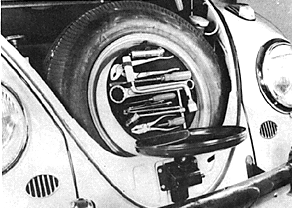Instructions for
Tropical Climate Operation
Tropical Climate Operation
5 - Tools and accessories

The standard tool kit should be supplemented by a set of extra tools which can be obtained from any VW Dealer. It is advisable to have the application of the various tools explained briefly by the service personnel.
Experience has proved that the following items can be very useful and are well worth carrying:
1 Set of extra tools, Part No. 111 016 025
Canister for reserve fuel as required
1 Grease gun (normal and high melting point grease as required)
5 Quarts of SAE 20 engine oil (for oil bath air cleaner)
1 Towrope
1 Block and tackle
5 Quarts of SAE 90 transmission oil
1 Tin of Genuine VW Brake Fluid
1 Bottle of distilled water
1 Tire pump
1 Tire pressure gauge
1 Inspection lamp (a suitable socket must be installed in the vehicle)
1 Support block (for eample - a board for placing under the jack. On soft ground a hub cap can be used as a support)
1 Tire repair kit
1 Compressed air bottle for tire inflation
1 Fuel funnel with sieve and leather filter
1 Fire etinguisher
1 First-aid kit
Two rolls of wire netting 50-60cm wide and 6 metres long can also be very handy in sandy areas.
6 - Spare parts
- The spare parts to be taken should be limited to the
essential parts subject to the most wear or accidental
damage as the space and weight required can only be
obtained at the expense of the remaining equipment.
Furthermore the VW Service Organisation guarantees the
availability of genuine spare parts in 100 different
countries all over the world.
It is also an unfortunate fact that even the most carefully thought out collection will not meet every emergency.
The following list of spare parts is only a rough general guide and the proper parts for the vehicle ccncerned should be listed by a VW Dealer who will also be able to quote the correct part numbers.
Suggested parts for the Passenger Car and Transporter:
1 Oil drain plug
1 Fuel pumpFor the rear axle:
2 Axle dust sleeves, splitFor the brake system:
1 Front brake hose
1 Rear brake hoseFor the electrical system:
3 Fan belts
1 Ignition coil
2 Sets of contact breaker points
12 Sets of fuses
2 Windshield wiper arms with blades
1 Set of bulbs
7 - Lubrication and maintenance
-
a - General
- The recommendations given in the Instruction Manual also apply to vehicles operating under etremely hot and dusty conditions. However, all points deserving particular attention are given below:
8 - Lubrication
-
a - Engine
- SAE 30 engine oil is recommended for use in localities where temperatures frequently rise above +30°C (86°F).
b - Front axle
- When a car is driven principally on bad roads, and in dusty conditions it is recommended that the front axle be lubricated at shorter intervals, say every 1,250 km (800 miles). Prior to lubricating, remove any dust and dirt from the grease nipples. The grease collars forming at the edges of the lubrication points when injecting grease should not be wiped off, as these serve as an additional protection against dust and sand.
9 - Maintenance
-
a - Air cleaner
- All air used for combustion must pass through the
air cleaner before it reaches the engine. Failure to
service the cleaner at proper intervals will adversely
affect the performance, increase the fuel consumption
and engine wear.
When the vehicle is driven in etremely dusty areas, the air cleaner should be cleaned more frequently. The air cleaner servicing is described in detail in the Instruction Manual under Maintenance.
Check the oil level once a day under exceptionally sandy or dusty conditions and top up as required. Check that the gaskets are properly located.
b - Fan belt
- To insure adequate cooling of the engine, particular attention should be paid to the tension and condition of the fan belt. Include the fan belt in your daily routine check and replace it as soon as signs of wear become evident.
c - Tires
- The inflation pressures given in the Instruction Manual should be strictly adhered to. The influence of continuous intense sunlight on tires is less harmful than generally believed. There is no need to cover the tires of vehicles parked in the sun.
d - Brakes
- Additional stress is placed on the brake drums and linings due to the ingress of sand and dust. To avoid dragging and seizure it is advisable to blow the drums out occasionally with compressed air if available. A tire pump can also be used in emergencies. The air should be directed into the adjuster hole in the backplate and the brake drum turned at the same time.
e - Battery
- The electrolyte level should be kept 5mm (.2") above the top of the plates. Check once a week and add only distilled water to correct the level. As high atmospheric temperatures promote a self-discharging, a specific gravity of 1.230 = 27° Bé is preferred for a charged battery. To maintain this specific gravity, take 240 ccm of electrolyte out of the battery and replace With a similar amount of distilled water. Finally check the specific gravity with a hydrometer and correct as necessary.
f - Fuel filter
- Check the filter once a week, and clean it as necessary.
- All air used for combustion must pass through the
air cleaner before it reaches the engine. Failure to
service the cleaner at proper intervals will adversely
affect the performance, increase the fuel consumption
and engine wear.